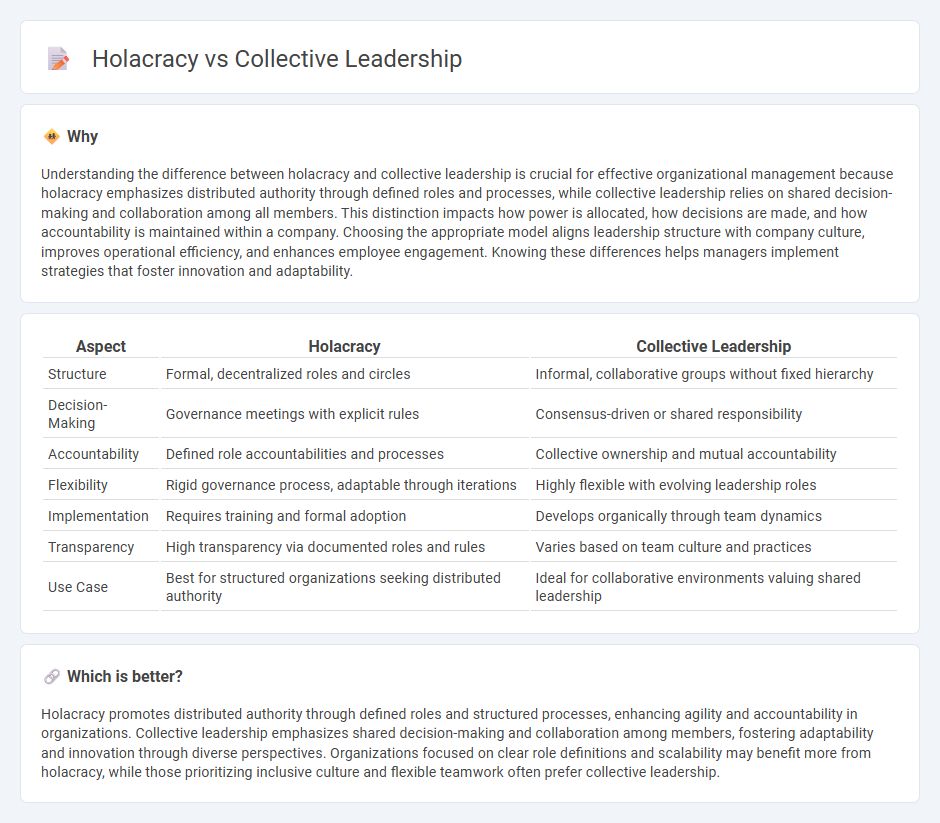
Holacracy distributes decision-making authority through self-organizing teams, eliminating traditional hierarchies to foster agility and autonomy in management. Collective leadership emphasizes shared responsibility and collaborative guidance among all members, enhancing inclusivity and diverse input in organizational processes. Explore the key differences and benefits of Holacracy and collective leadership to transform your management approach.
Why it is important
Understanding the difference between holacracy and collective leadership is crucial for effective organizational management because holacracy emphasizes distributed authority through defined roles and processes, while collective leadership relies on shared decision-making and collaboration among all members. This distinction impacts how power is allocated, how decisions are made, and how accountability is maintained within a company. Choosing the appropriate model aligns leadership structure with company culture, improves operational efficiency, and enhances employee engagement. Knowing these differences helps managers implement strategies that foster innovation and adaptability.
Comparison Table
| Aspect | Holacracy | Collective Leadership |
|---|---|---|
| Structure | Formal, decentralized roles and circles | Informal, collaborative groups without fixed hierarchy |
| Decision-Making | Governance meetings with explicit rules | Consensus-driven or shared responsibility |
| Accountability | Defined role accountabilities and processes | Collective ownership and mutual accountability |
| Flexibility | Rigid governance process, adaptable through iterations | Highly flexible with evolving leadership roles |
| Implementation | Requires training and formal adoption | Develops organically through team dynamics |
| Transparency | High transparency via documented roles and rules | Varies based on team culture and practices |
| Use Case | Best for structured organizations seeking distributed authority | Ideal for collaborative environments valuing shared leadership |
Which is better?
Holacracy promotes distributed authority through defined roles and structured processes, enhancing agility and accountability in organizations. Collective leadership emphasizes shared decision-making and collaboration among members, fostering adaptability and innovation through diverse perspectives. Organizations focused on clear role definitions and scalability may benefit more from holacracy, while those prioritizing inclusive culture and flexible teamwork often prefer collective leadership.
Connection
Holacracy and collective leadership both emphasize decentralized decision-making by distributing authority across teams rather than concentrating power in a traditional hierarchy. Holacracy implements structured roles and governance processes to facilitate shared leadership and accountability within organizations. Collective leadership fosters collaboration and inclusive participation, aligning with holacracy's goal of empowering individuals to drive organizational agility and innovation.
Key Terms
Decision-making Authority
Collective leadership distributes decision-making authority among a group, empowering team members to collaborate and share responsibility, while holacracy formalizes this process through structured roles and governance meetings that define clear domains of authority. In collective leadership, decisions arise from consensus or shared input, whereas holacracy relies on explicit role-based authority and a constitution to guide decision-making within circles. Explore how these distinct frameworks impact organizational agility and employee empowerment to choose the best fit for your team.
Role Distribution
Collective leadership emphasizes shared decision-making and accountability among all members, promoting flexible role distribution based on skills and expertise. Holacracy enforces a structured role distribution through defined circles and governance processes, ensuring clarity and autonomy within each role. Explore the nuances of role distribution in both models to determine the best fit for your organization.
Team Autonomy
Collective leadership emphasizes shared decision-making and mutual accountability within teams, promoting high levels of collaboration and empowerment. Holacracy implements a structured system of distributed authority with defined roles and governance processes to enhance organizational agility and self-management. Explore how these distinct approaches to team autonomy can transform your organizational culture.
Source and External Links
What Is Collective Leadership? - PON - Collective leadership involves a group of diverse individuals working together to achieve shared goals through collaborative decision-making and shared responsibility.
Collective Leadership in Business - Plecto - Collective leadership in business is characterized by multiple leaders making decisions and managing the organization, emphasizing shared responsibility and accountability.
Collective Leadership Institute - The Collective Leadership Institute empowers individuals and systems to lead collectively, focusing on transformation literacy and stakeholder collaboration.
 dowidth.com
dowidth.com